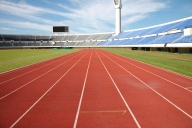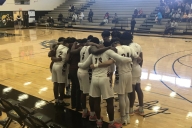You have /5 articles left.
Sign up for a free account or log in.
A federal judge's ruling Friday went a long way toward defining the parameters of a closely watched lawsuit challenging National Collegiate Athletic Association policies limiting players' rights to be compensated for commercial use of their likenesses. The decision provided significant victories (and defeats) both to the athletes and to the NCAA.
The ruling by Judge Claudia Wilken puts athletes -- if they ultimately win on the case's merits -- on a path to claim a share of television and other revenue that now flows almost entirely to colleges, coaches and the NCAA, in a way that could challenge the underlying "amateurism" model of big-time college sports. But it also shields the NCAA from the sort of short-term billion-dollar cash judgment that could have immediately blown a hole in the financial viability of big-time college sports.
The antitrust lawsuit, O'Bannon v. National Collegiate Athletic Association, argues that athletes should receive a share of the revenue generated off their “likeness” -- their image or an image implying a given athlete, such as a video game avatar with a specific jersey color and number. The NCAA asserts that paying athletes in that way would clash with the bedrock principle of "amateurism" that underlies college athletics.
The legal challenge, brought in federal district court in California by a group of former athletes led by the former University of California at Los Angeles basketball star Ed O'Bannon, has already rattled around the courts for nearly five years. But it is on track for trial next June, in the wake of two key decisions: last month's ruling by the judge rejecting the NCAA's motion to dismiss the case, which would have stopped it in its tracks, and Friday's ruling on whether to certify the athletes as a "class," which was essentially about how broad the impact will be if the plaintiffs should ultimately win.
Two key questions were at stake in the judge's ruling: Should the lawsuit be certified so that all former and current players in big-time football and basketball programs (rather than just the individual athletes who sued the NCAA) would be eligible, going forward, to challenge the association's policies restricting players from being compensated for use of their likenesses, and to benefit if those policies are overturned? And should all former and current big-time football and basketball players be able to sue the NCAA for monetary damages for harm they suffered from those policies?
The judge certified the class on the first step, for injunctive relief, a major victory for the plaintiffs. What that means is that if the court ultimately holds that the NCAA's policies violate federal antitrust law, and that athletes deserve a cut of revenues that they help to generate, whatever union or association of players would represent athletes at that negotiating table would be broadly representative of all players in the class, rather than a few dozen individuals. That led lawyers for the plaintiffs to call it a "victory for all current and former student-athletes who are seeking compensation on a going forward basis."
"The NCAA is now threatened with a large class of persons who are going to try to challenge amateurism in court," said Michael McCann, founding director of the Sports and Entertainment Law Institute at the University of New Hampshire School of Law. "If there would be a federal court order finding that those rules are not in play -- changing the view of amateurism as we've known it for decades -- all of these persons across the country would be affected by the order. That would have a much bigger impact on the college sports market."
Threatening as that may sound to the NCAA, Judge Wilken's ruling also contained some good news for the association in the nearer term. She rejected the plaintiffs' bid to certify a class for damages based on the NCAA's past policies. If the ruling had gone the other way, and the court ultimately found that the NCAA's policies had resulted in the improper use of athletes' names and likenesses, all past and current players in the class would have been eligible for damages, which could have soared into the billions of dollars.
As it is under Wilken's ruling, the individual plaintiffs could still be eligible for damages if the NCAA loses the case, and other individuals could sue later. But the scale of the potential damages is presumably greatly lessened, limiting the prospect of immediate devastation to the business model of big-time college sports even if the NCAA were to lose the suit.
“We have long maintained that the plaintiffs in this matter are wrong on the facts and wrong on the law. This ruling is one step closer to validating that position," the NCAA's chief legal counsel, Donald Remy, said in a statement. "We are pleased that the Court correctly found that conducting a class-wide trial for claimed damages for student-athletes who played college football and men’s basketball going back nearly a decade would be completely unmanageable and unprecedented. The plaintiffs in this case were seeking substantial damages based on erroneous theories for maintaining a class."
The Ruling's Implications
By taking some things off the table -- namely the prospect of a massive financial judgment against the NCAA and college sports in the short term -- and increasing the likelihood of others -- notably a broad-scale challenge to the association's cherished definition of amateurism that could compel sweeping changes in the operating model of college athletics -- Judge Wilken's ruling most of all increases the likelihood of a settlement in the case, most legal experts agreed.
"Both sides now have a better understanding of the potential value of the litigation to college athletes and its potential cost to the NCAA and its members," McCann said in an article in Sports Illustrated. "The case is not as valuable as O'Bannon had sought, especially for former student-athletes, but the prospect of college athletes being compensated in the future would still constitute a hefty new cost for colleges."
Paul H. Haagen, a professor of law at Duke University and co-director of its Center for Sports Law and Policy, said the NCAA is unlikely to want to risk the possibility that a court could undercut the NCAA's approach to amateurism in the broadest possible way, far beyond the question of whether athletes should share in the compensation for use of their images.
"If the court orders it, they may lose control, so there's a powerful incentive to try to reach some kind of settlement," Haagen said.
The NCAA's current definition of amateurism is pretty flexible, Haagen said; its current approach, he said, is essentially "we can pay athletes as long as we say we can pay them -- they are amateurs if they take payments that we allow."
So there are a lot of things the NCAA could do, he said, to "maintain control of the situation consistent with its traditions in a negotiating position," Haagen said. The association could pay athletes $2,000 (or $10,000) in living expenses, or permit group licensing for use of their images in all non-live-broadcast forms, for instance.
While the NCAA has historically won most previous challenges to its amateurism model, Haagen said, public opinion -- in part driven by the issues raised in the O'Bannon case -- has shifted to the point that the association is unlikely to be able to count on its run continuing.









